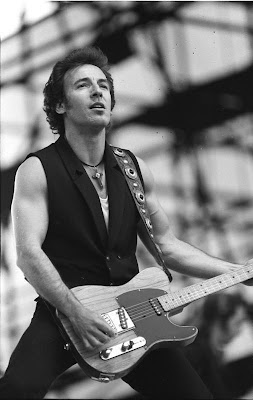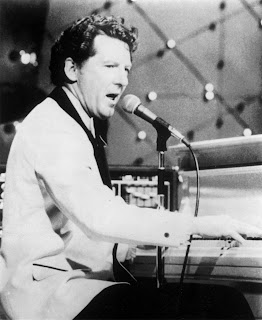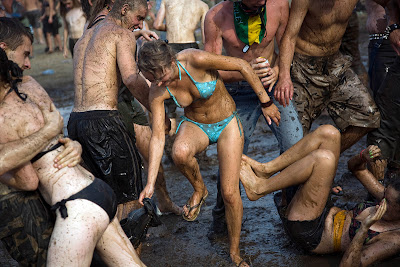 |
| The Clash |
Punk rock
Punk rock was developed between 1974 and 1976 in the United States and the United Kingdom. Rooted in garage rock and other forms of what is now known as protopunk music, punk rock bands eschewed the perceived excesses of mainstream 1970s rock. They created fast, hard-edged music, typically with short songs, stripped-down instrumentation, and often political, anti-establishment lyrics. Punk embraces a DIY (do it yourself) ethic, with many bands self-producing their recordings and distributing them through informal channels.
By late 1976, acts such as the Ramones and Patti Smith, in New York City, and the Sex Pistols and The Clash, in London, were recognized as the vanguard of a new musical movement. The following year saw punk rock spreading around the world. Punk quickly, though briefly, became a major cultural phenomenon in the United Kingdom. For the most part, punk took root in local scenes that tended to reject association with the mainstream. An associated punk subculture emerged, expressing youthful rebellion and characterized by distinctive clothing styles and a variety of anti-authoritarian ideologies.
By the beginning of the 1980s, faster, more aggressive styles such as hardcore and Oi! had become the predominant mode of punk rock.[151] Since punk rock's initial popularity in the 1970s and the renewed interest created by the punk revival of the 1990s, punk rock continues to have a strong underground following. This has resulted in several evolved strains of hardcore punk, such as D-beat (a distortion-heavy subgenre influenced by the UK band Discharge), anarcho-punk (such as Crass), grindcore (such as Napalm Death), and crust punk. Musicians identifying with or inspired by punk also pursued a broad range of other variations, giving rise to New Wave, post-punk and the alternative rock movement.
 |
| The Go-Go's |
New Wave
Although punk rock was a significant social and musical phenomenon, it achieved less in the way of record sales (being distributed by small specialty labels such as Stiff Records), or American radio airplay (as the radio scene continued to be dominated by mainstream formats such as disco and album-oriented rock). Punk rock had attracted devotees from the art and collegiate world and soon bands sporting a more literate, arty approach, such as Talking Heads, and Devo began to infiltrate the punk scene; in some quarters the description "New Wave" began to be used to differentiate these less overtly punk bands. Record executives, who had been mostly mystified by the punk movement, recognized the potential of the more accessible New Wave acts and began aggressively signing and marketing any band that could claim a remote connection to punk or New Wave. Many of these bands, such as The Cars, and The Go-Go's can be seen as pop bands marketed as New Wave; other existing acts, including The Police, The Pretenders and Elvis Costello, used the New Wave movement as the springboard for relatively long and critically successful careers, while "skinny tie" bands exemplified by The Knack, or the photogenic Blondie, began as punk acts and moved into more commercial territory.
Between 1982 and 1985, influenced by Kraftwerk, David Bowie, and Gary Numan, British New Wave went in the direction of such New Romantics as Spandau Ballet, Ultravox, Duran Duran, A Flock of Seagulls, Culture Club, Talk Talk and the Eurythmics, sometimes using the synthesizer to replace all other instruments. This period coincided with the rise of MTV and led to a great deal of exposure for this brand of synthpop, creating what has been characterised as a second British Invasion. Some more traditional rock bands adapted to the video age and profited from MTV's airplay, most obviously Dire Straits', whose "Money for Nothing" gently poked fun at the station, despite the fact that it had helped make them international stars, but in general guitar-oriented rock was commercially eclipsed.
 |
| Jim O'Rourke additional guitarist of Sonic Youth |
Post-punk
If hardcore most directly pursued the stripped down aesthetic of punk, and New Wave came to represent its commercial wing, post-punk emerged in the later 1970s and early '80s as its more artistic and challenging side. Major influences beside punk bands were The Velvet Underground, The Who, Frank Zappa and Captain Beefheart, and the New York based no wave scene which placed an emphasis on performance, including bands such as James Chance and the Contortions, DNA and Sonic Youth. Early contributors to the genre included the US bands Pere Ubu, Devo, The Residents and Talking Heads.
The first wave of British post-punk included Gang of Four, Siouxsie and the Banshees and Joy Division, who placed less emphasis on art than their US counterparts and more on the dark emotional qualities of their music. Bands like Siouxsie and the Banshees, Bauhaus, The Cure, and The Sisters of Mercy, moved increasingly in this direction to found Gothic rock, which had become the basis of a major sub-culture by the early 1980s. Similar emotional territory was pursued by Australian acts like The Birthday Party and Nick Cave. Members of Bauhaus and Joy Division explored new stylistic territory as Love and Rockets and New Order respectively. Another early post-punk movement was the industrial music developed by British bands Throbbing Gristle and Cabaret Voltaire, and New York-based Suicide, using a variety of electronic and sampling techniques that emulated the sound of industrial production and which would develop into a variety of forms of post-industrial music in the 1980s.
The second generation of British post-punk bands that broke through in the early 1980s, including The Fall, The Pop Group, The Mekons, Echo and the Bunnymen and Teardrop Explodes, tended to move away from dark sonic landscapes. Arguably the most successful band to emerge from post-punk was Ireland's U2, who incorporated elements of religious imagery together with political commentary into their often anthemic music, and by the late 1980s had become one of the biggest bands in the world. Although many post-punk bands continued to record and perform, it declined as a movement in the mid-1980s as acts disbanded or moved off to explore other musical areas, but it has continued to influence the development of rock music and has been seen as a major element in the creation of the alternative rock movement.
 |
| Iron Maiden |
New waves and genres in heavy metal
Although many established bands continued to perform and record, heavy metal suffered a hiatus in the face of the punk movement in the mid-1970s. Part of the reaction saw the popularity of bands like Motörhead, who had adopted a punk sensibility, and Judas Priest, who created a stripped down sound, largely removing the remaining elements of blues music, from their 1978 album Stained Class. This change of direction was compared to punk and in the late 1970s became known as the New Wave of British Heavy Metal (NWOBHM). These bands were soon followed by acts including Iron Maiden, Vardis, Diamond Head, Saxon, Def Leppard and Venom, many of which began to enjoy considerable success in the USA. In the same period Eddie Van Halen established himself as a metal guitar virtuoso after his band's self-titled 1978 album. Randy Rhoads and Yngwie Malmsteen also became established virtuosos, associated with what would be known as the neoclassical metal style.
Inspired by NWOBHM and Van Halen's success, a metal scene began to develop in Southern California from the late 1970s, based on the clubs of L.A.'s Sunset Strip and including such bands as Quiet Riot, Ratt, Mötley Crüe, and W.A.S.P., who, along with similarly styled acts such as New York's Twisted Sister, incorporated the theatrics (and sometimes makeup) of glam rock acts like Alice Cooper and Kiss. The lyrics of these glam metal bands characteristically emphasized hedonism and wild behavior and musically were distinguished by rapid-fire shred guitar solos, anthemic choruses, and a relatively melodic, pop-oriented approach. By the mid-1980s bands were beginning to emerge from the L.A. scene that pursued a less glam image and a rawer sound, particularly Guns N' Roses, breaking through with the chart-topping Appetite for Destruction (1987), and Jane's Addiction, who emerged with their major label debut Nothing's Shocking, the following year.
In the late 1980s metal fragmented into several subgenres, including thrash metal, which developed in the US from the style known as speed metal, under the influence of hardcore punk, with low-register guitar riffs typically overlaid by shredding leads. Lyrics often expressed nihilistic views or deal with social issues using visceral, gory language. It was popularised by the "Big Four of Thrash": Metallica, Anthrax, Megadeth, and Slayer. Death metal developed out of thrash, particularly influenced by the bands Venom and Slayer. Florida's Death and the Bay Area's Possessed emphasized lyrical elements of blasphemy, diabolism and millenarianism, with vocals usually delivered as guttural "death growls," high-pitched screaming, complemented by downtuned, highly distorted guitars and extremely fast double bass percussion. Black metal, again influenced by Venom and pioneered by Denmark's Mercyful Fate, Switzerland's Hellhammer and Celtic Frost, and Sweden's Bathory, had many similarities in sound to death metal, but was often intentionally lo-fi in production and placed greater emphasis on satanic and pagan themes. Bathory were particularly important in inspiring the further sub-genres of Viking metal and folk metal. Power metal emerged in Europe in the late 1980s as a reaction to the harshness of death and black metal and was established by Germany's Helloween, who combined a melodic approach with thrash's speed and energy. England's DragonForce and Florida's Iced Earth have a sound indebted to NWOBHM, while acts such as Florida's Kamelot, Finland's Nightwish, Italy's Rhapsody of Fire, and Russia's Catharsis feature a keyboard-based "symphonic" sound, sometimes employing orchestras and opera singers. In contrast to other sub-genres doom metal, influenced by Gothic rock, slowed down the music, with bands like England's Pagan Altar and Witchfinder General and the United States' Pentagram, Saint Vitus and Trouble, emphasizing melody, down-tuned guitars, a 'thicker' or 'heavier' sound and a sepulchral mood. American bands such as Queensrÿche and Dream Theater pioneered an often instrumentally challenging fusion of NWOBHM and progressive rock called progressive metal, with bands such as Symphony X combining aspects of power metal and classical music with the style, while Sweden's Opeth developed a unique style indebted to both death metal and atmospheric 70s prog rock.
 |
| Bruce Springsteen in East Berlin in 1988 |
Heartland rock
American working-class oriented heartland rock, characterized by a straightforward musical style, and a concern with the lives of ordinary, blue collar American people, developed in the second half of the 1970s. The term heartland rock was first used to describe Midwestern arena rock groups like Kansas, REO Speedwagon and Styx, but which came to be associated with a more socially concerned form of roots rock more directly influenced by folk, country and rock and roll. It has been seen as an American Midwest and Rust Belt counterpart to West Coast country rock and the Southern rock of the American South. Led by figures who had initially been identified with punk and New Wave, it was most strongly influenced by acts such as Bob Dylan, The Byrds, Creedence Clearwater Revival and Van Morrison, and the basic rock of '60s garage and the Rolling Stones.
Exemplified by the commercial success of singer songwriters Bruce Springsteen, Bob Seger, and Tom Petty, along with less widely known acts such as Southside Johnny and the Asbury Jukes and Joe Grushecky and the Houserockers, it was partly a reaction to post-industrial urban decline in the East and Mid-West, often dwelling on issues of social disintegration and isolation, beside a form of good-time rock and roll revivalism. The genre reached its commercial, artistic and influential peak in the mid-1980s, with Springsteen's Born in the USA (1984), topping the charts worldwide and spawning a series of top ten singles, together with the arrival of artists including John Mellencamp, Steve Earle and more gentle singer/songwriters such as Bruce Hornsby. It can also be heard as an influence on artists as diverse as Billy Joel, Kid Rock and The Killers.
Heartland rock faded away as a recognized genre by the early 1990s, as rock music in general, and blue collar and white working class themes in particular, lost influence with younger audiences, and as heartland's artists turned to more personal works. Many heartland rock artists continue to record today with critical and commercial success, most notably Bruce Springsteen, Tom Petty and John Mellencamp, although their works have become more personal and experimental and no longer fit easily into a single genre. Newer artists whose music would perhaps have been labelled heartland rock had it been released in the 1970s or 1980s, such as Missouri's Bottle Rockets and Illinois' Uncle Tupelo, often find themselves labeled alt-country.
 |
| R.E.M |
The emergence of alternative rock
The term alternative rock was coined in the early 1980s to describe rock artists who did not fit into the mainstream genres of the time. Bands dubbed "alternative" had no unified style, but were all seen as distinct from mainstream music. Alternative bands were linked by their collective debt to punk rock, through hardcore, New Wave or the post-punk movements. Important alternative rock bands of the 1980s in the US included R.E.M., Hüsker Dü, Jane's Addiction, Sonic Youth, and the Pixies, and in the UK The Cure, New Order, The Jesus and Mary Chain, and The Smiths. Artists were largely confined to independent record labels, building an extensive underground music scene based on college radio, fanzines, touring, and word-of-mouth. They rejected the dominant synthpop of the early 1980s, marking a return to group-based guitar rock.
Few of these early bands, with the exceptions of R.E.M. and The Smiths, achieved mainstream success, but despite a lack of spectacular album sales, they exerted a considerable influence on the generation of musicians who came of age in the 1980s and ended up breaking through to mainstream success in the 1990s. Styles of alternative rock in the U.S. during the 1980s included jangle pop, associated with the early recordings of R.E.M., which incorporated the ringing guitars of mid-1960s pop and rock, and college rock, used to describe alternative bands that began in the college circuit and college radio, including acts such as 10,000 Maniacs and The Feelies. In the UK Gothic rock was dominant in the early 1980s, but by the end of the decade indie or dream pop like Primal Scream, Bogshed, Half Man Half Biscuit and The Wedding Present, and what were dubbed shoegaze bands like My Bloody Valentine, Ride, Lush, Chapterhouse, and the Boo Radleys. Particularly vibrant was the Madchester scene, produced such bands as Happy Mondays, the Inspiral Carpets, and Stone Roses. The next decade would see the success of grunge in the United States and Britpop in the United Kingdom, bringing alternative rock into the mainstream.
 |
| Pixies |












 08.02
08.02
 deKILL
deKILL





































